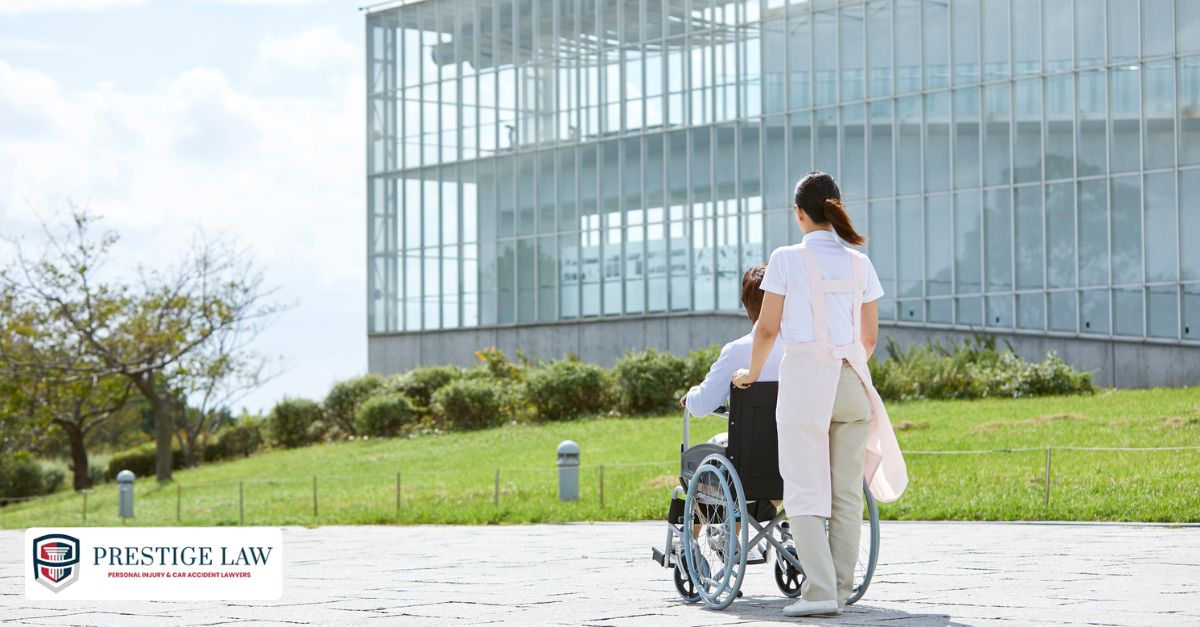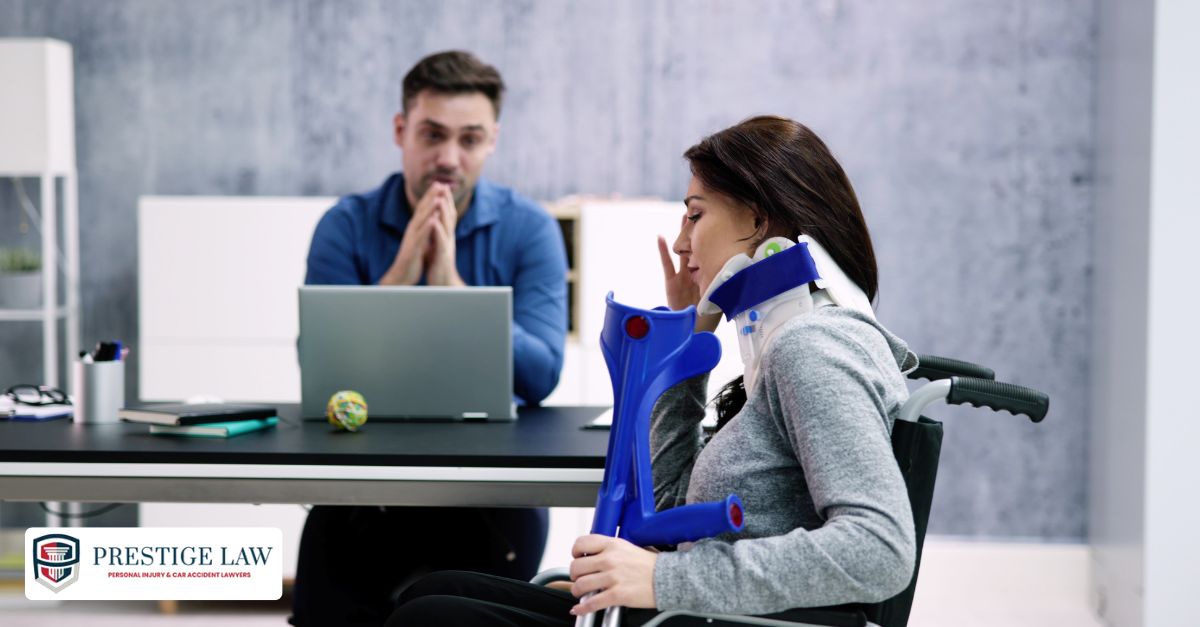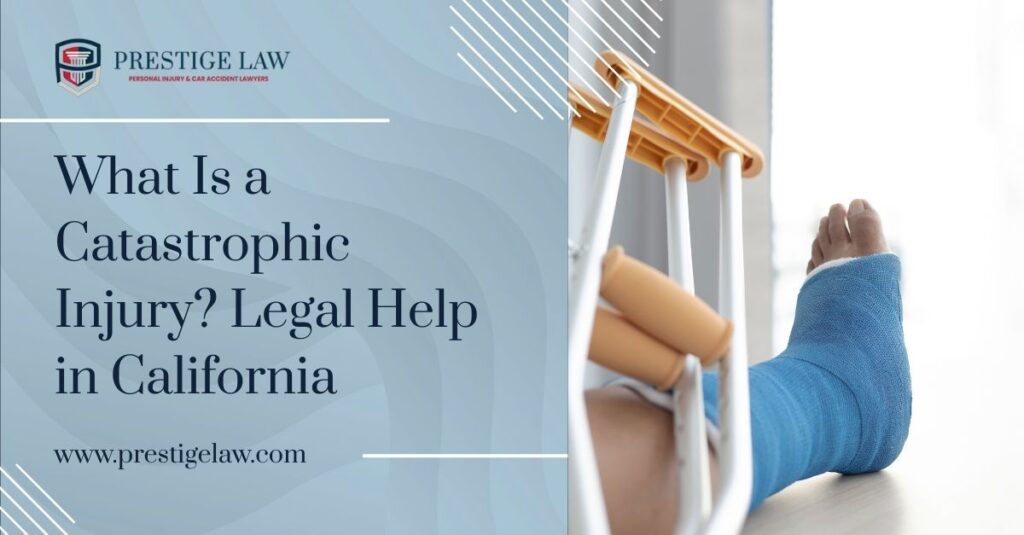
Catastrophic Injuries: Legal Rights and Next Steps
Published on / Category: Catastrophic Injuries
A catastrophic injury changes everything—your body, your livelihood, your independence. One moment, life is normal. The next, you’re facing permanent damage that impacts every part of your world.
These aren’t just serious injuries that take time to heal. Catastrophic injuries leave lasting effects. They can limit how you move, work, communicate, and care for yourself. They affect your finances, your future, and your family.
The legal system treats them differently, too. Because the stakes are so high, these cases are more complex—and the outcomes matter more than ever.
If you or someone you love is living with this kind of injury, it’s not just about healing. It’s about protecting your dignity, getting financial support, and fighting for justice.
But how do you know if your injury qualifies as “catastrophic” under California law? And why does that classification matter?
At a Glance:
Catastrophic injuries cause permanent, life-changing damage—like paralysis, brain trauma, or limb loss—and often require lifelong care. Victims in California may be entitled to compensation for medical costs, lost wages, and pain and suffering. Prestige Law Firm P.C. helps clients recover maximum compensation with personalized legal support.
What is a catastrophic injury?
A catastrophic injury is one that causes permanent or long-term harm—physically, emotionally, and financially. It doesn’t just affect your health.
It affects how you live, work, and take care of yourself.
Medically, this kind of injury often involves serious damage to the brain, spinal cord, or limbs. It can mean paralysis, loss of mobility, or permanent cognitive changes. These injuries often require lifelong care, assistive devices, and ongoing rehabilitation.
Legally, a catastrophic injury is one that prevents a person from returning to any kind of gainful employment. In other words, it takes away your ability to earn a living the way you did before the accident.
In California, this classification matters. When your injury meets the legal definition of “catastrophic,” it can affect:
- How much compensation you can receive
- Whether long-term disability or medical care is covered
- How insurers and the court system treat your case
For victims and their families, being legally recognized as having suffered a catastrophic injury opens the door to greater financial and medical support—help that’s often critical to rebuilding life after a traumatic event.
What qualifies as a catastrophic injury?
Catastrophic injuries aren’t just defined by what part of the body is hurt—they’re defined by how deeply they affect your ability to live, move, and work.
Below are the most common types that courts and insurers often classify as catastrophic:
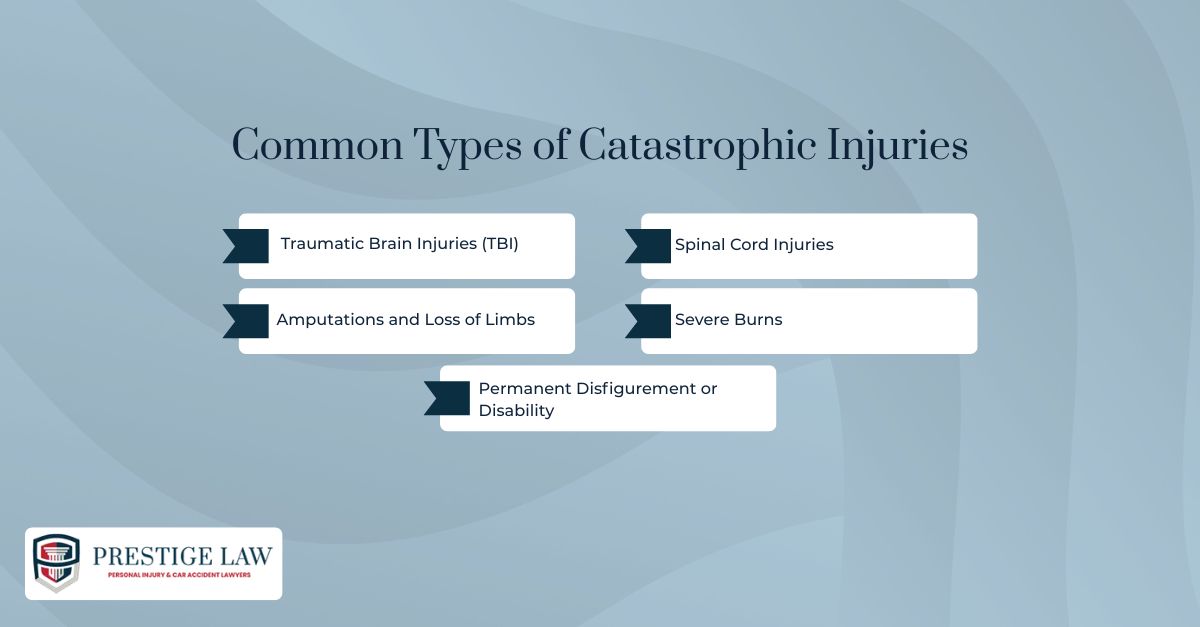
Traumatic Brain Injuries (TBI)
Serious TBIs can cause memory loss, mood swings, speech problems, and difficulty with balance or movement. Many victims struggle with daily tasks or need full-time care.
Spinal Cord Injuries
Damage to the spinal cord can lead to paralysis, chronic pain, and loss of control over certain bodily functions. Most people with major spinal injuries require wheelchairs, in-home support, or major home modifications.
Amputations and Limb Loss
Losing a hand, arm, leg, or foot is physically and emotionally devastating. Even with prosthetics, these injuries limit mobility, independence, and job opportunities. Recovery also includes extensive physical therapy and relearning basic skills.
Severe Burns
Burn injuries can lead to disfigurement, nerve damage, and mobility problems—alongside the risk of infection, long hospital stays, and multiple surgeries. The emotional toll can be just as lasting as the physical one.
Permanent Disfigurement or Disability
Other life-altering injuries, like vision or hearing loss, complex internal injuries, or severe fractures that limit mobility, may also qualify. If the damage is permanent and impacts your quality of life, it is often treated as catastrophic.
These injuries don’t just affect one area of life—they change everything: work, independence, relationships, and financial stability. In the most serious cases, they may even result in wrongful death, giving surviving families the right to pursue a legal claim.
The Process of Making a Catastrophic Injury Claim
Filing a catastrophic injury claim isn’t just paperwork—it’s a legal process that requires strong evidence, strategic planning, and skilled advocacy.
Here’s what you can expect if you decide to pursue a claim:
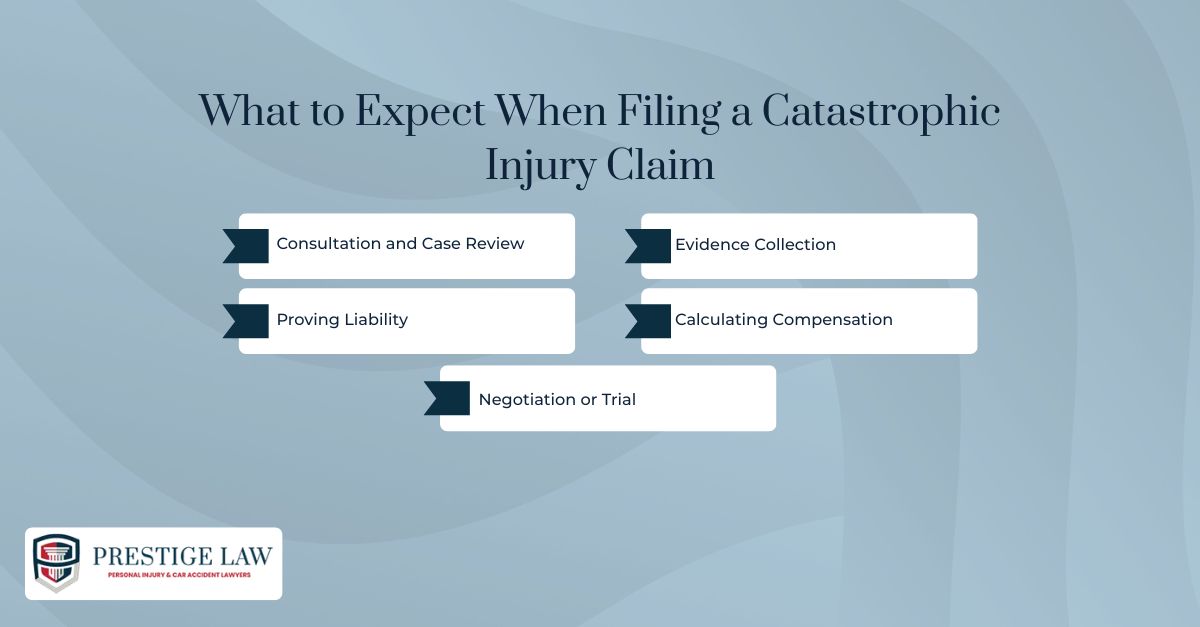
1. Consultation and Case Review
Your attorney starts by reviewing your medical records and the details of the incident. This initial consultation helps determine whether you have a valid case and what kind of compensation might be available.
2. Evidence Collection
Once your case is accepted, your lawyer will begin gathering evidence. This may include accident reports, medical records, photographs, witness statements, and expert medical opinions. The goal is to prove how the injury happened and how severely it has affected your life.
3. Proving Liability
You must show that someone else’s negligence caused your injury. That could mean a reckless driver, a property owner who failed to fix a hazard, an employer who ignored safety protocols, or a medical professional who made a preventable mistake.
4. Calculating Compensation
Catastrophic injury claims involve more than just current medical bills. Your legal team will calculate the full impact of the injury, including lost income, future treatment, caregiving needs, and pain and suffering.
5. Negotiation or Trial
Most cases settle through negotiations with the responsible party’s insurance company. But if a fair offer isn’t made, your attorney can take the case to trial and fight for a verdict that reflects the true value of your loss.
These cases are complex—but with the right legal support, you don’t have to go through it alone. The sooner you act, the sooner you can get the care, stability, and compensation you deserve.
How are catastrophic injury settlements calculated?
There’s no standard number for a catastrophic injury settlement. Each case is unique, but the same key factors often shape the outcome:
Severity and Permanence of the Injury
The more serious and long-lasting the injury, the greater the potential compensation. Injuries like paralysis, brain trauma, or amputation typically lead to higher payouts because of their life-altering impact.
Medical Expenses — Past and Future
Settlements include not only emergency care and surgeries, but also long-term needs like rehab, medications, assistive devices, and nursing care.
Future treatment projections are often backed by medical experts.
Lost Income and Reduced Earning Capacity
If you can’t return to work—or must switch to a lower-paying job—your future earnings may be reduced for life. Settlements account for both missed paychecks and diminished career opportunities.
Pain and Suffering
This refers to both physical pain and emotional trauma. The more the injury limits your movement, freedom, or sense of identity, the more compensation may be awarded for your suffering.
Lifestyle Changes and Home Modifications
Some victims need to remodel their homes for accessibility or hire in-home help. These costs are factored into settlement amounts to reflect long-term needs.
Permanent Disability or Disfigurement
Visible injuries or loss of function that affects daily living often increase settlement values, especially when they impact confidence, social interactions, or independence.
Punitive Damages (in Rare Cases)
If the injury was caused by gross negligence or intentional harm, courts may award additional money to punish the wrongdoer. This is rare, but it can significantly raise the total amount awarded.
Determining the full value of a catastrophic injury takes legal insight, expert evaluation, and strategic negotiation. At Prestige Law Firm P.C., we leave no detail out—and no dollar on the table.
Why Choose Prestige Law Firm P.C. for Your Catastrophic Injury Case
When a catastrophic injury changes your life, you need more than basic legal help—you need a firm that understands what’s at stake and has the experience to win.
Focused on Serious Injury Cases
Prestige Law Firm P.C. handles only personal injury matters, with a particular focus on catastrophic injuries like spinal cord trauma, brain injuries, amputations, and permanent disability cases.
Led by a Proven Attorney
Founding attorney Paul Aghabala brings over two decades of experience fighting for injured Californians. He personally oversees every case—no hand-offs to junior lawyers or case managers.
Deep Resources and Expert Access
Our team partners with top medical experts, life care planners, and economists to calculate damages and project your long-term needs accurately—giving your case the strongest foundation.
Efficient, Compassionate Case Handling
We work quickly to get you medical treatment, vehicle replacements, rental support, and lost wages while building your case. You focus on healing—we handle everything else.
You Don’t Pay Unless We Win
With our no recovery, no fee policy, you never pay out-of-pocket. We only get paid when we successfully recover compensation for you.
Serving All of Southern California
Whether you’re in Van Nuys, Palmdale, or anywhere in Los Angeles County, we’re here to fight for you. We understand the fear, stress, and urgency that follow a devastating injury—and we’ll be there every step of the way.
Conclusion
Catastrophic injuries change everything—from your health and independence to your job, relationships, and daily routine. These aren’t short-term problems. They’re life-altering challenges that demand serious legal and financial support.
If you or a loved one is facing the aftermath of a catastrophic injury, the law gives you the right to seek compensation—not just for medical bills, but for lost income, long-term care, pain, suffering, and more.
At Prestige Law Firm P.C., we don’t take that responsibility lightly. With decades of experience, a personal approach, and a track record of results, we’re here to stand by your side—fighting for the resources you need to move forward.
We understand the pressure you’re under, and we’re here to make the process as clear, compassionate, and effective as possible. Let us handle the legal battle while you focus on healing.
Contact us today at (818) 788-0808 or (661) 341-3939, or email paul@prestigelaw.com. Your recovery starts with a free consultation.
How is a catastrophic injury different from a serious injury?
A serious injury may heal over time, while a catastrophic injury causes permanent damage and often leads to long-term disability, requiring lifelong care.
Do I need a lawyer for a catastrophic injury claim?
Yes. These cases are complex and high-value. A lawyer helps prove liability, calculate future damages, and negotiate for the maximum compensation you deserve.
What compensation can I get for a catastrophic injury?
You may be entitled to medical expenses, lost income, reduced earning capacity, pain and suffering, home modifications, and long-term care costs.
Can a car accident lead to a catastrophic injury case?
Absolutely. High-speed or severe collisions often cause life-changing injuries such as paralysis, brain damage, or amputations—qualifying for catastrophic injury claims.
Get Started Today!
24 hours a day / 7 days a week / 365 days a year
Contact our Los Angles and Antelope team of attorneys for a free consultation.


